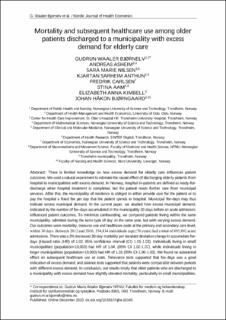| dc.description.abstract | There is limited knowledge on how excess demand for elderly care influences patient outcomes. We used a natural experiment to estimate the causal effect of discharging elderly patients from hospital to municipalities with excess demand. In Norway, hospital in-patients are defined as ready-for-discharge when hospital treatment is completed, but the patient needs further care from municipal services. After this, the municipality of residence is obliged to either provide care for the patient or to pay the hospital a fixed fee per day that the patient spends in hospital. Municipal fee-days may thus indicate excess municipal demand. In the current paper, we studied how excess municipal demand, indicated by the number of fee-days accumulated in the municipality 30 days before an acute admission, influenced patient outcomes. To minimize confounding, we compared patients living within the same municipality, admitted during the same type of day, in the same year, but with varying excess demand. Our outcomes were mortality, resource use and healthcare costs at the primary and secondary care level, within 30 days. Between 2012 and 2016, 354,834 individuals (age≥70 years) had a total of 895,892 acute admissions. There was a 2% increased 30-day mortality per standard deviation change in accumulate fee-days (Hazard ratio (HR) of 1.02, 95% confidence interval (CI) 1.01-1.03). Individuals living in small municipalities (population<10,000) had HR of 1.04, (95% CI 1.02-1.07), while individuals living in larger municipalities (population>10,000) had HR of 1.01 (95% CI 1.00-1.03). We found no substantial effect on subsequent healthcare use or costs. Relevance tests supported that fee-days was a good indication of excess demand, and balance tests supported that patients were comparable between periods with different excess demand. In conclusion, our results imply that older patients who are discharged to a municipality with excess demand have slightly elevated mortality, particularly in small municipalities. | en_US |

